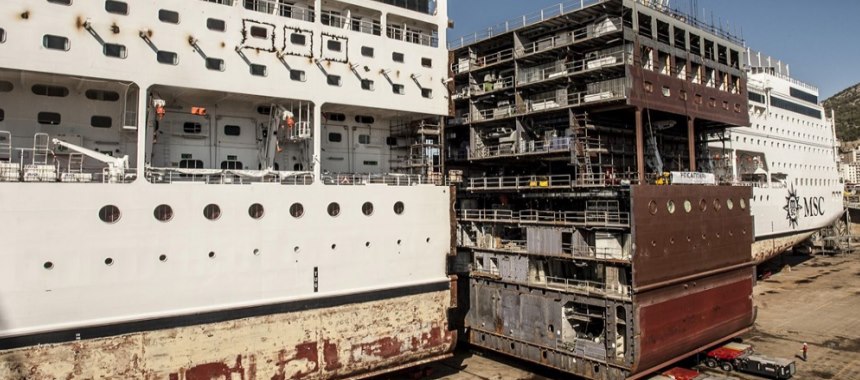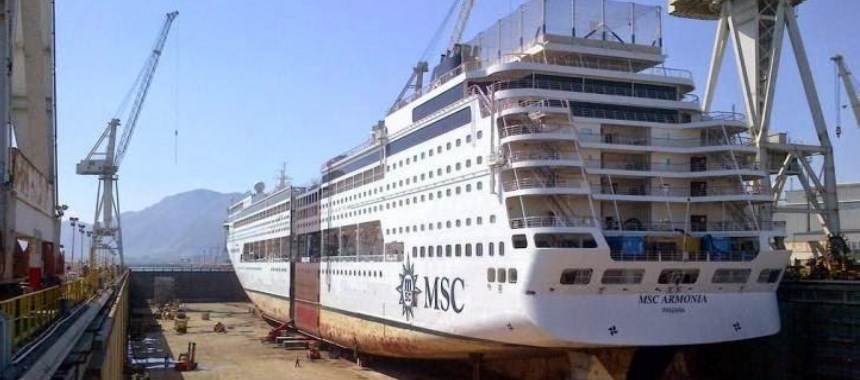Four MSC liners have become larger

MSC (Mediterranian Shipping Company), founded in 1970, is the world's second largest shipping company. In 1980, for the purpose of serving tourists, the MSC Cruises division was founded, which by that time had only three passenger ships. Today the fleet of vessels has grown significantly and has 13 units and several thousand employees. It is headed by four vessels with a total tonnage of 140 thousand tons and a length of 333.3 m with 3 502 tourist places and 1 388 crew members.
From the beginning to the middle of the last decade, the French ship company STX France for MSC Cruises built a series of Lirica liners of four ships with a capacity of 60 thousand tons and a length of 251 m; each of them could take on board 2199 passengers. Recently, the company decided to increase their passenger capacity, having allocated on it 200 million dollars. Preparation for this was begun in 2013. For the beginning, the vessel MSC Armonia was chosen.
The Italian shipyard Fincantieri has received and fulfilled an unusual order — to increase the length of the vessel, the number of cabins, public spaces and to transfer the vessel to the customer no later than 11 weeks after the commencement of work. The shipyard, however, had no experience in such complex operations, because «behind the shoulders» only cargo ships.
To accomplish such a task, the passenger vessel must be cut in a precisely defined place in two, pushing both parts a distance of the length of the new part of the vessel. The 251-meter-long liner should be brought into dry dock, first exposing the blocks and filling it with water. After this, the dock is drained and starts to be cut. It is designed in a place where the body is almost cylindrical — the shape of the underwater part of the insert will be simpler, which will facilitate the subsequent connection. The passenger vessel is much more difficult to cut in comparison with the cargo ship, because the ship has many decks, highly developed communication networks, water systems, sewerage, ventilation and lighting. An autopsy is performed from the top down to reduce possible deformations by pre-supporting the decks. The operation time was reduced to 5 days, which is much less than that achieved by other firms — 3-4 months. Dimensions of the dry dock of 370 m by 68 m allowed to move along the rails the nose part weighing 14 thousand tons for 25 meters ahead. In Italy it was the first time. Traditionally, after this, the dock is filled with water and one of the parts of the vessel is taken out of it, an insert is inserted, and the previously deduced part is installed after it. Sometimes, at first, an insert is inserted into a pre-prepared place, two parts are joined, a new one and an old one, and only then the latter is added. This operation is both more complicated and more expensive.
However, the Italians bypassed the «wet phase». Installation of the insert weighing 2 200 tons and a length of 23.7 m occurred directly in the dock, next to the extended vessel. After the separation of the parts of the vessel, the section mounted on the carriages was turned 90 degrees and inserted into place without filling the dock with water. This provided a fairly fast and, of course, accurate connection of all three parts into one.
Convergence of large and heavy parts of the vessel with the required accuracy of up to 20 mm — the work is laborious: hydraulic jacks work, temporary structures are used, accuracy is checked by laser devices. Butt joints between parts of the body are welded by a certain technology to reduce the possibility of welding deformations, especially since the seam is multilayered. To oversee the work on the liner MSC Armonia and the next MSC Sinfonia involved representatives of RINA (Italian Register) and BV (Bureau Veritas, France) for the other two vessels.
While this process is underway, the underwater part is cleaned of fouling, with the final phase — by spraying with sand, preparing it for coating with silicone paints. Looking ahead, it should be noted that this is not a one-off action. Several layers of soil and paint are applied to the body, and finally an antifouling coating. The quality of the seams is checked for the uniformity of welded metal, water resistance and only after that the body is prepared for painting. In addition, internal structures are also connected, as well as ship systems. All connections are carefully checked before and after work is completed. Improved and fire fighting system. Dock the new part of the vessel above and below the waterline. Only after this continue to finish the interiors, including for children of different ages. A room for the library and a self-service buffet are added.
But this is not the end — you need to check the watertightness of the whole ship with water and air. And only after that the shipyard and representatives of the customer acknowledge that the passenger ship is ready for withdrawal from the dock. This is also not an easy task, especially when the water area is not too spacious. Its depths are taken into account for safe withdrawal of the liner. In some cases, calculate the time of the tide and try to keep it during its operation.
Such a difficult work was performed by the shipyard just in time. The extended MSC Armonia had a length of 251 m before entering the dock on August 31, 2014, and on November 17 of the same year it was 274.7 m long.
 Extension of a cruise liner
Extension of a cruise liner
 Extension of a cruise liner
Extension of a cruise liner
The extension of the liner gave the following results: an increase in passenger capacity by 480 seats to 2 679, the number of crew for 36 people to 721, the number of cabins for 106, the restaurant area for 600 square meters for 280 seats. On the sixth deck the living room is extended by 330 sq.m, the area of open decks — on 250 sq.m., and the water park on 11 deck — on 250 sq.m. Instead of windows, 96 cabins received balconies of 3.5 square meters. In addition, two 150-seat and two 50-seat rescue boats, as well as 500-seat inflatable rafts, have been added. The capacity of fuel, water, ballast and waste tanks has been increased. A wide replacement of lamps with LEDs is made. The power of two bow thrusters is increased from 1 400 to 2 200 kW. The experience gained made it possible to schedule a modernization of three more vessels of the MSC Sinfonia, MSC Opera and MSC Lirica series, which will be completed in November 2015.
The cruise liner MSC Armonia left Genoa on November 19 last year for its first updated flight to the Canary Islands, visiting Marseille, Cartagena, Gibraltar, Cadiz, Funchal, Santa Cruz de la Palma, Santa Cruz de Tenerife and Las Palmas de Gran Canaria.
It is estimated that the lengthening of the vessel led to a decrease in cruise speed from 21,7 knots by 0.6 knots. And apparently this did not affect the performance indicators. However, the final conclusion will be made after full-scale tests, because the task is not only to maintain speed, but also to save fuel.
The increase in passenger seats on four Lirica ships after modernization does not remove from the agenda the construction of two new Seaside-class liners with a tonnage of 154,000 tons, which are to begin cruises in November 2017 and May 2018.
Increasing the length of vessels is a world-famous practice. This method of modernization is much cheaper than building a new vessel. Such operations are performed by various shipbuilding enterprises and shipyards and with such quality that an enlarged vessel immediately leaves the line.
- Comments
 en
en ru
ru uk
uk




